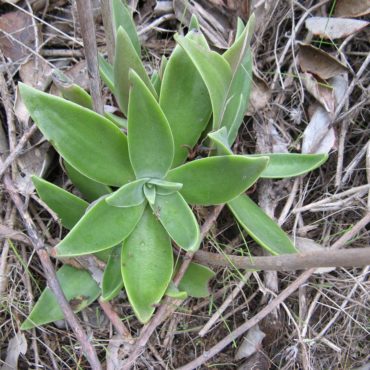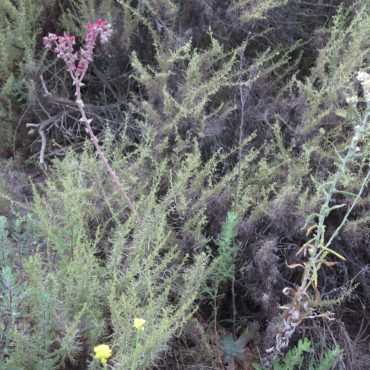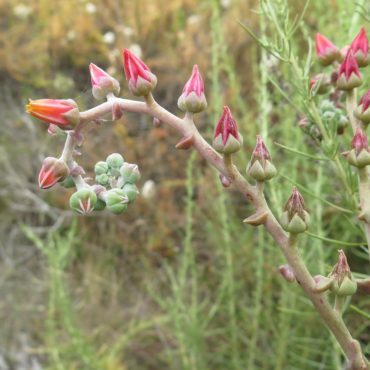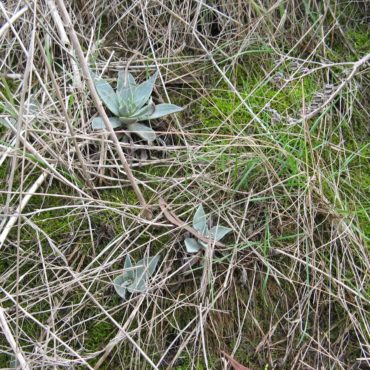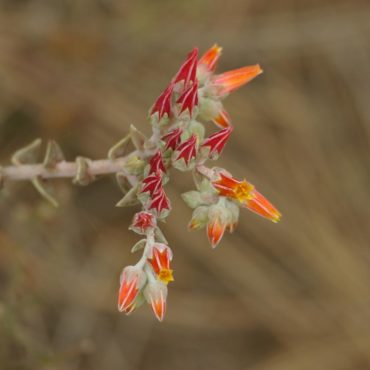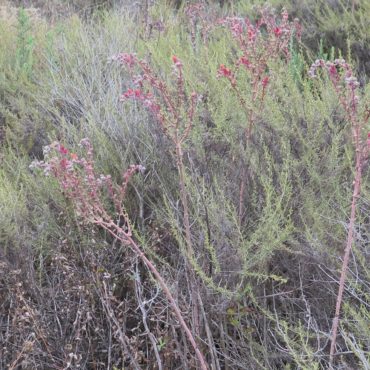There are three species of Dudleya in the Reserve. Lance-leaved dudleya (D. lanceolata) is the shy one. While chalk dudleya (D. pulverulenta) and lady-fingers (D. edulis) display their rosettes boldly clinging to exposed rock cliffs and walls, lance-leaved dudleya hides beneath the surrounding vegetation, lifting flowers into the sun, where they provide little pops of color in the greens and grays of the sage scrub.
Lance-leaved Dudleya
Dudleya lanceolata
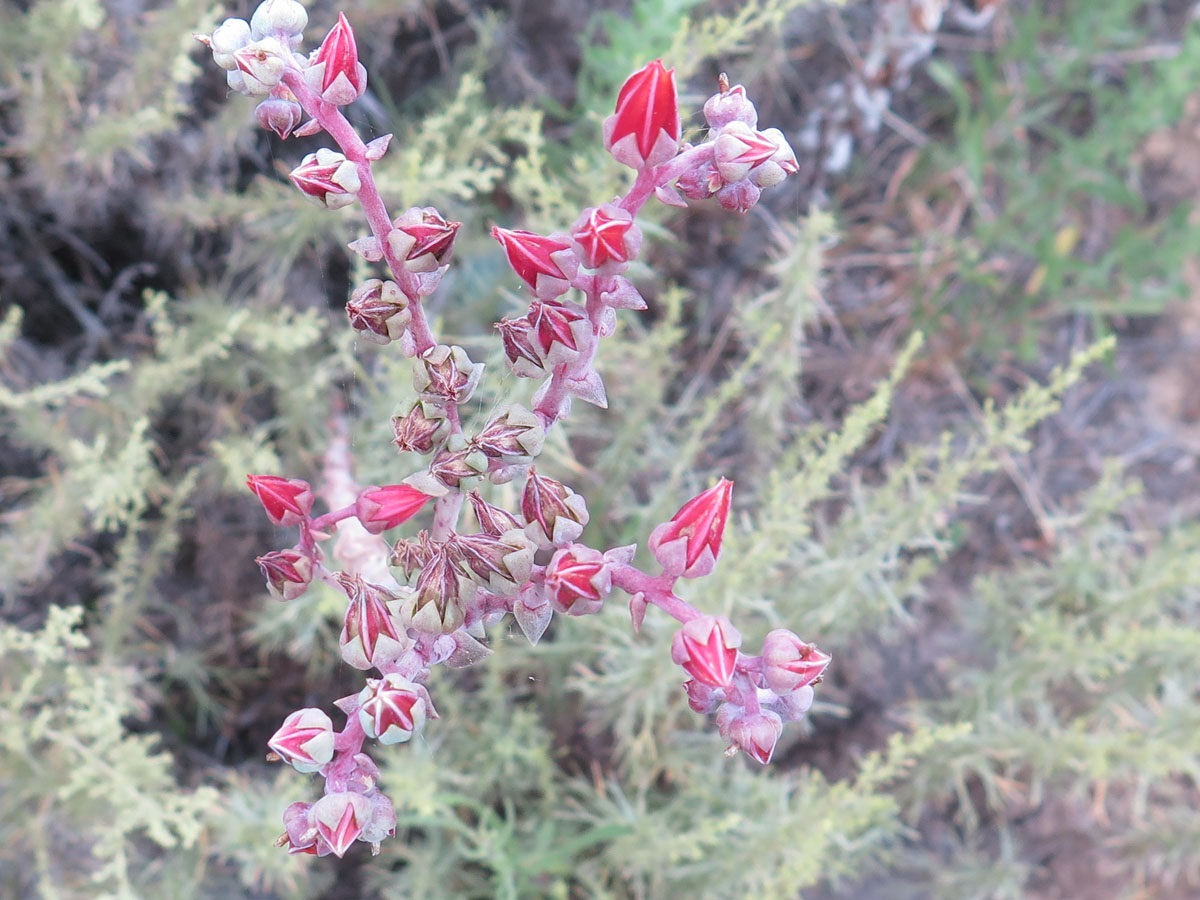
Other Common Names:
Lance-leaved Live-forever, Escheveria
Description 4,11,23,59
Lance-leaved dudleya is a succulent, evergreen herb with a short, thick stem (caudex) that produces a dense basal rosette of fleshy, sessile leaves, sometimes retaining a few dead leaves around the base. Rosettes may occur in small clusters. The fleshy leaves are green in color, sometimes tinged with red and sometimes with a light dusting of chalky powder. They are triangular to oval, lanceolate or oblanceolate in shape, usually less than ten inches (25 cm) long and 1 ¼ inches (3 cm) wide with an acute tip.
One to five or more long flower stalks (peduncle) arise between the basal leaves. Rosettes are often tucked deep within the surrounding vegetation,290 while the flower stalks wind upward through the brush, lifting the flowers 20 or more inches (50 cm) into the sun. Flower stalks are sparsely covered with small fleshy triangular bracts that wither from the base as the flowers age. Peduncles typically fork into several coiled flowering stems that unfurl as flowers open.
Flowers of lance-leaved dudleya resemble those of chalk dudleya, but they are held erect rather than hanging downward. The calyx is five-lobed and fleshy. The five elongated, overlapping petals form a long tube, very narrow at the throat and flaring out at the end. Reports of flower color include bright yellow,306 orange or pale green with a red tinge35 and generally red.2 In the Reserve, most floral tubes are red with yellow inside the mouth and often yellow or white on the midrib. There are ten stamens that do not extend out of the tube. The anthers and pollen are yellow. The five pistils are fused at the base with superior ovaries. Ovaries taper to short styles with small stigmas that barely reach the mouth of the floral tube. Lance-leaved dudleya blooms primarily between April and July.468
The five fertilized fruits develop within the envelope of the dried corolla and calyx. When mature, each fruit splits open releasing numerous tiny seeds less than 1/32 inch (0.1 cm) in length.
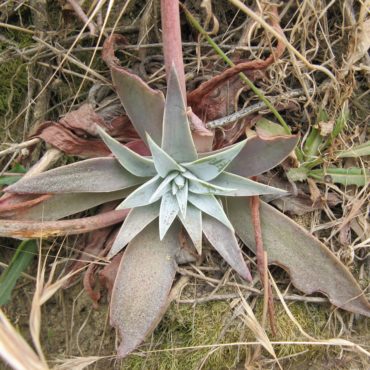
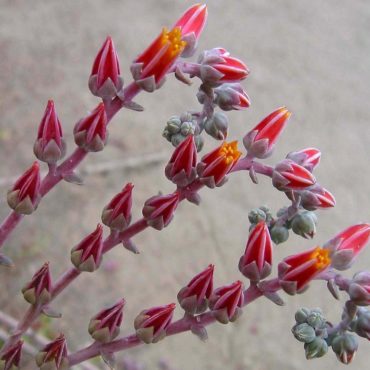
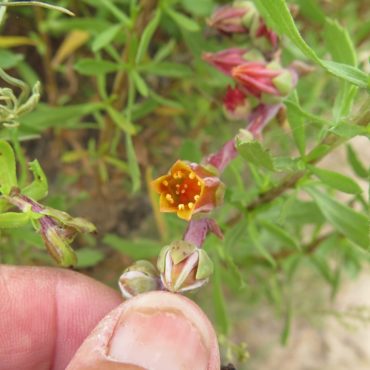
Distribution 7,11,89
Lance-leaved dudleya is native to central and southern California and northern Baja California west of the Southern Coast and Peninsular Ranges and below 3500 feet. In California it occurs in coastal sage scrub and chaparral where it prefers steep slopes and rocky banks. Within its range, lance-leaved dudleya is the most common species of this genus.2
In the Reserve, lance-leaved dudleya can be seen in several areas along the trails, especially along the south side of Central Basin, on banks where the trail cuts the base of the slope.
Learn more about plant vegetation types here
Classification
Lance-leaved dudleya is a dicot angiosperm in the stonecrop family (Crassulaceae), a family centered in South Africa but found worldwide except in Australia and the southwest Pacific islands. Members of this family are mostly succulent herbs. The typical stonecrop flower has three to five unfused sepals and three to five petals. The number of stamens is equal to or double the number of petals. There are three to five pistils. Fruits consist of three to five unfused, dry, tear-drop shaped, one-chambered capsules.
There are many architecturally diverse, ornamental plants in the stonecrop family, including jade plant (Crassula ovata), and species of Sedum, Aeonium, Echeveria and Kalanchoe.41,206
Species in the Dudleya genus typically have thick, fleshy leaves in a rosette from a woody base.11 They are distinguished from similar genera by small differences in flower morphology. In 2014 there were 46 species of Dudleya recognized. More than half of the species are listed as rare or endangered by the California Native Plant Society.429
There are three species of dudleyas reported in the Reserve.48 In addition to lance-leaved dudleya, we have chalk dudleya (D. pulverulenta) and ladies’-fingers (D. edulis). Other species have been planted around the Nature Center.
Alternate Scientific Names:
Dudleya lanceolata, Dudleya elongata, Echeveria lanceolata, Dudleya brauntonii, Dudleya congesta, Dudleya cymosa, Dudleya goldmanii, Dudleya lurida, Dudleya nevadensis
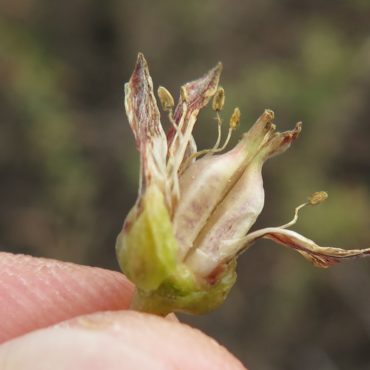
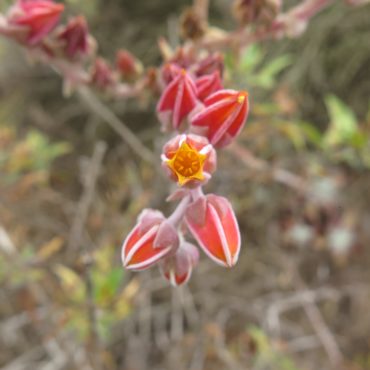
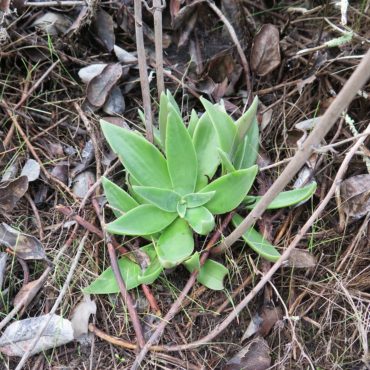
Ecology
Lance-leaved dudleyas are pollinated mainly by large bees and only occasionally by hummingbirds.59 This contrasts the chalk dudleya which is a hummingbird specialist492 – in spite of the two species having flowers that appear – to us – quite similar. The flowers of both are primarily red, a color attractive to hummingbirds but invisible to bees.86 However, the red flowers of lance-leaved dudleya have yellow accents, and some plants have primarily yellow flowers. Yellow has been shown to attract bee pollinators. The yellow is concentrated around the mouth of the flower tube. It is possible that this yellow spot is a nectar guide for bees, directing them precisely to the nectar and pollen sources.87
A second difference between the chalk dudleya and the lance-leaved dudleya is the orientation and location of the flowers. In the former, the flowers are pendant and the stalk often extends far above the surrounding vegetation, giving the hummingbird lots of air space to hover and maneuver. The upright blossoms of lance-leaved dudleya, on the other hand, are often surrounded by neighboring vegetation so the airspace is crowded.
There remains the possibility that the lance-leaved dudleya flower has patterns in the ultra-violet part of the spectrum.347 Although these are invisible to us, they often signal bees, guiding them into the flower.87
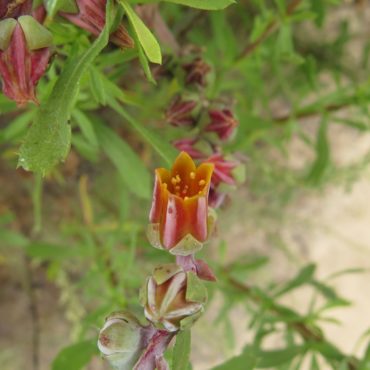
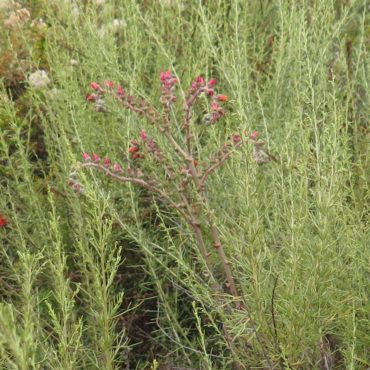
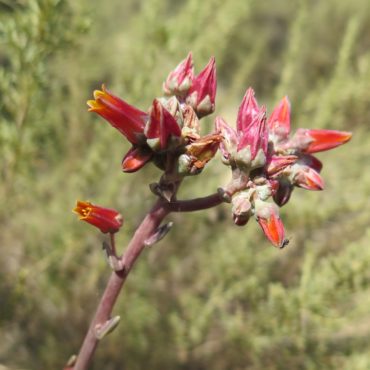
Human Uses
There are few reports of use of any species of Dudleya by native Americans. One authority writes “…it [a plant in the genus] was more than likely regarded as a curiosity than a plant of great utilitarian promise.”36
Local Kumeyaay ate the raw leaves of lance-leaved dudleya.16 Kumeyaay are also reported to have chewed the tender leaves (of unspecified Dudleya species) to alleviate thirst, and to have eaten the very young flower stalks, which were reported to be sweet and juicy.272
With the growing interest in xeriscaping, the use of dudleyas in the garden is increasing168,290 – to the point that there is growing theft of plants from their native habitat.428,430 Dudleyas must never be taken from the wild. Excellent material can be obtained from legitimate nurseries that grow their stock from nursery stock.
